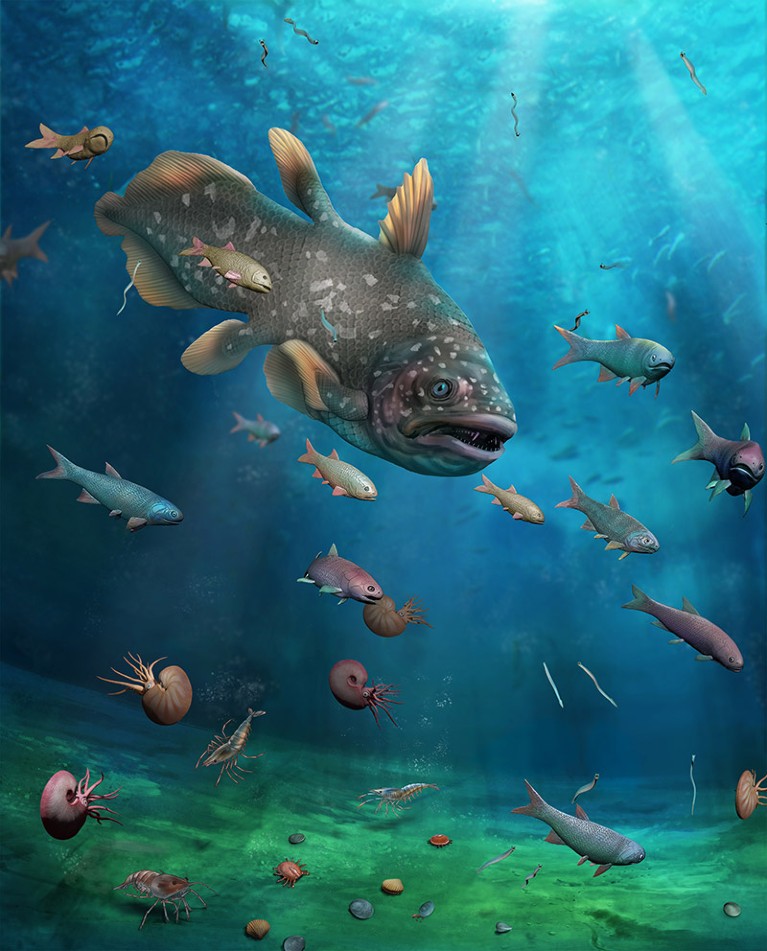

Sea life bounced back fast after the ‘mother of mass extinctions’
source link: https://www.nature.com/articles/d41586-023-00383-9
Go to the source link to view the article. You can view the picture content, updated content and better typesetting reading experience. If the link is broken, please click the button below to view the snapshot at that time.

Sea life bounced back fast after the ‘mother of mass extinctions’

The Guiyang biota from China reveals a complex marine ecosystem that lived 250 million years ago (artist’s impression).Credit: Dinghua Yang, Haijun Song
An exceptionally well-preserved trove of fossils uncovered in southern China represents a complex marine ecosystem from the dawn of modern life, according to a study published in Science today1. The organisms of the Guiyang biota lived around 251 million years ago, just one million years after the world’s worst known mass-extinction event, at the end of the Permian period. This suggests that ecosystems recovered much more rapidly than previously thought.
Palaeontologist Xu Dai discovered the fossils in 2015, when he was at the China University of Geosciences in Wuhan. Between 2015 and 2019 — before the COVID-19 pandemic interrupted fieldwork — he and his colleagues collected more than 1,000 fossils of whole fish, ancient lobsters and prehistoric crab-like creatures from a layer of black shale at six sites to the east of Guiyang in Guizhou province.
Volcanic ash in the layer dates to 250.8 million years ago. That makes the Guiyang biota the oldest known fossil assemblage from the Mesozoic era, the interval between the Permian–Triassic mass extinction and the Cretaceous–Paleogene mass extinction that wiped out non-avian dinosaurs 66 million years ago.
It’s an “extraordinary” discovery, says palaeontologist Guang Shi at the University of Wollongong in Australia.
The great dying
The Permian–Triassic mass extinction — sometimes called the mother of mass extinctions — obliterated large swathes of life on Earth, including more than 80% of ocean-dwelling species. The event is thought to have been caused by global warming triggered by volcanic activity that heated Earth’s atmosphere and acidified the oceans.
It was thought to have been so profound that it took millions of years for complex ecosystems, including top-level predators, to recover fully. In 2012, palaeontologists Zhong-Qiang Chen at the China University of Geosciences and Mike Benton at the University of Bristol, UK, hypothesized2 that ecosystem recovery happened in steps, with a pyramid-shaped food web building up one level at a time — from self-sufficient organisms to apex predators.
Their work was based on another complex fossilized ecosystem in southern China — the Luoping biota — which dates to ten million years after the mass extinction. “When we did that work, it looked as if the recovery was quite delayed,” says Benton. But with the Guiyang biota discovery, “they’ve disproven us”, he says.
Rapid recovery
The fossils that Dai and his colleagues collected from the Guiyang biota comprise a complete pyramid of food-web tiers, from single-celled shelled foraminifers that would have fed on marine algae to sponges, bivalves, lobster relatives and predatory fish. Considering how soon after the mass extinction these organisms lived, “the diversity is remarkable”, says Shi.
Dai, now at the University of Burgundy in Dijon, France, says that the appearance of the Guiyang biota so soon after the end-Permian mass extinction calls into question the step-wise model of ecosystem recovery. A quicker recovery process probably began with the survivors of the mass extinction, he says.
A rapid diversification of predatory fishes suggests that the complex ecosystem did not really disappear during the mass extinction, says co-author Arnaud Brayard, a palaeontologist at the University of Burgundy.
The Guiyang biota includes some organisms that are more closely related to modern marine life than to their Permian relatives — and some organisms that existed both before and after the extinction. The finding “really changes our understanding of how soon or how rapidly the ecosystem recovery took place”, says Shi. But he says that it doesn’t rule out a multistage process. “I don’t think we can draw, just from this discovery, that it didn’t take a step-wise fashion in the ecosystem rebuilding,” he says.
Benton says that the emerging picture is of a time in which ecosystems recovered swiftly before being hit by repeated temperature shocks throughout the first eight million years of the early Triassic period. “What’s now coming out is even more extraordinary, that the rate of recovery can be really super-fast, unexpectedly, against the backdrop of really grim conditions,” he says. But Benton, too, thinks that self-sufficient organisms would have come first, followed by species that consumed those animals, and then apex predators.
After three years with no fieldwork, Dai is planning to return to the Guiyang sites in the middle of this year to see what else they will yield. He is also keen to find sites — perhaps on the Tibetan Plateau — that hold fossils that lived during the one million years between the Permian mass extinction and the Guiyang biota.
Recommend
About Joyk
Aggregate valuable and interesting links.
Joyk means Joy of geeK